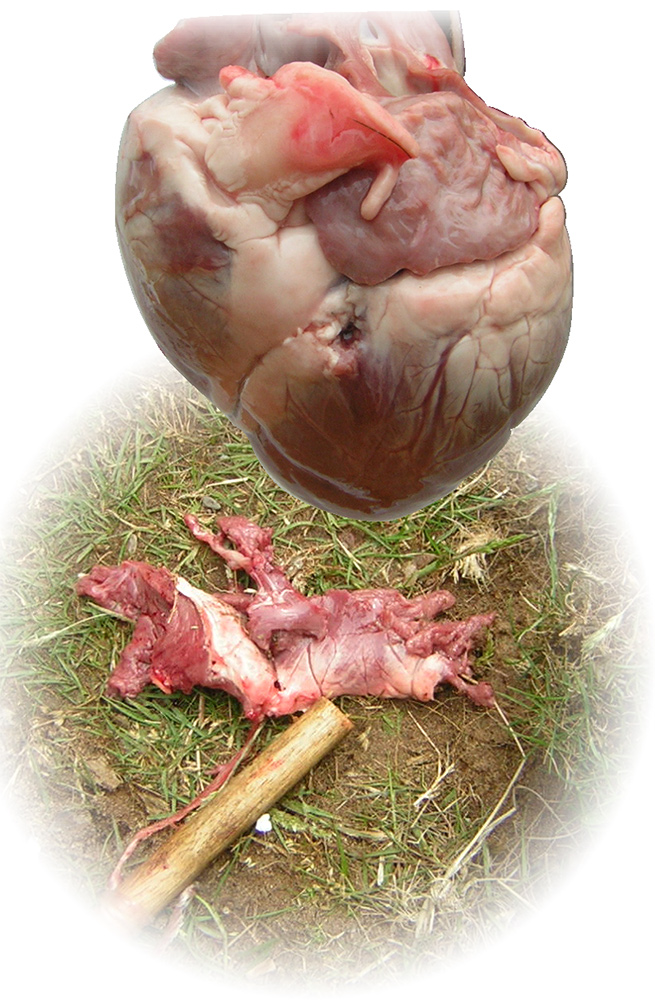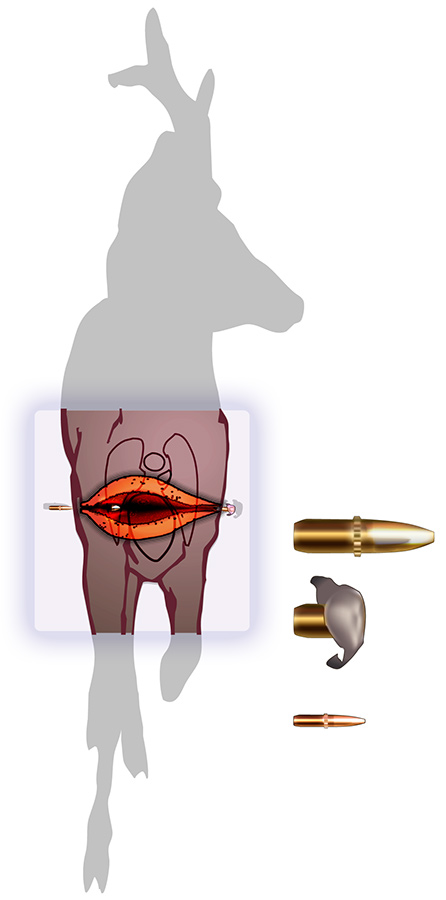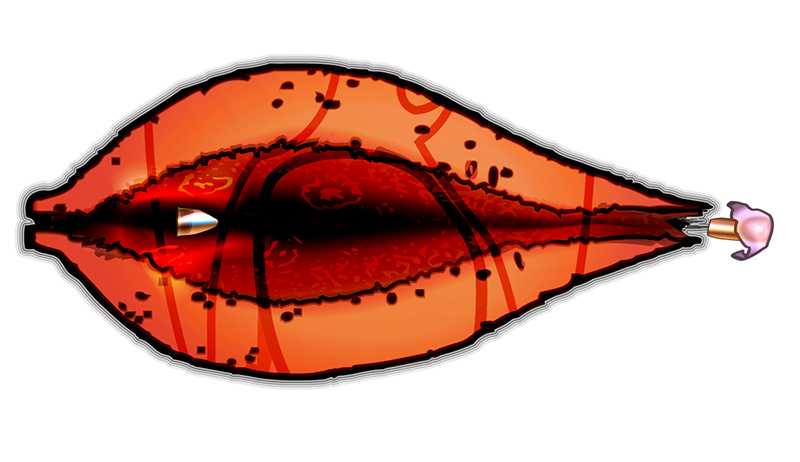
Aim
The aim of this guide is to describe the factors to be considered when choosing a rifle and ammunition combination to shoot deer in Scotland. This guide will specifically cover:
- The legal limitations on what firearms can be used;
- A description of why expanding ammunition is required to shoot deer;
- Bullet trajectory, drop and the effects of wind.
Legal limitations
For the killing or taking of deer in Scotland, firearms, ammunition and sights must conform to requirements, laid down in the Deer (Firearms etc.)(Scotland) Order1985, as amended in November 2023:
- Rifles:
| Deer Species | Min Bullet Weight | Min Muzzle Velocity | Min Muzzle Energy |
| for all species | 80 grains (5.2 grams) | 2,450 ft/sec (746.76 mtrs/sec) |
1,750 foot pounds (2,373 joules) |
| for Roe only | 50grains (3.24grams) | 2,450 ft/sec (746.76 mtrs/sec) |
1,000 foot pounds (1,356 joules) |
NB. Practitioners must ensure that their chosen rifle, calibre and ammunition combination meets all of the minimum legal requirements for bullet weight and type, muzzle velocity and muzzle energy for the species of deer they are targeting. This can be done by testing through a chronograph and referencing with associated load data
- Rifle bullets must be of an expanding type designed to deform in a predictable manner.
- Shotguns:
Use is limited to certain circumstances and must be of not less than 12 bore gauge
| Deer Species | Non spherical rifled slug | Shot size | Weight of shot |
| for all species | 380 grains(24.62 g) | SSG ie no less than 0.268 inches (6.81 mm) in diameter | at least 550 grains (35.64 g) |
| for Roe only | 380 grains(24.62 g) | AAA ie no less than 0.203 inches (5.16 mm) in diameter | at least 450 grains (29.16 g) |
- It is lawful to use a slaughtering instrument using any ammunition intended for use in it. A ‘slaughtering instrument’ is a firearm specifically designed or adapted for the instantaneous slaughter of animals or for the instantaneous stunning of animals with a view to slaughtering them. Such an instrument may be appropriate for use in capture for culling operations.
- Any firearm or other method of humane dispatch may be used to prevent suffering to injured or wounded deer.
- Light intensifying, heat sensitive or other special sighting devices, including digital sights, can be used to cull deer during day light hours. The use of conventional sights, light intensifying, heat sensitive or other special sighting devices, including digital sights at night are subject to a Section 18 Authorisation
Legal Implications
- Section 17(3) Deer Act (Scotland) 1996 makes it an offence to wilfully kill or injure any deer other than by shooting with an approved firearm and ammunition.
- Section 19 Firearms Act (1968): Carrying a firearm in a public place:
A person commits an offence if, without lawful authority or reasonable excuse (the proof whereof lies with him) he has with him in a public place:
• a loaded shotgun
• an air weapon (whether loaded or not)
• any other firearm together with ammunition suitable for use in that firearm
• an imitation firearm. - Section 20 Firearms Act (1968): Trespass with firearm:
If you trespass in a building or on land with a firearm, or imitation firearm, and cannot prove a reasonable excuse, you commit an offence. - Part 1 Land Reform (Scotland) Act 2003 establishes access rights that must be exercised responsibly. The Scottish Outdoor Access Code (SOAC) provides guidance on responsibilities. SOAC includes activities that are excluded from access rights. Section 2.12 includes carrying of any firearm, except where.. crossing land.. to immediately access or return from land where shooting rights are granted.
In addition, there may be a risk of offences around Reckless Discharge, Breach of the Peace/ Fear and Alarm and Causing Unnecessary Suffering
Ref: BPG Deer In and Around Towns, Guidance on Responding to Situations.
Why use expanding ammunition?

(top) solid ammunition produces little transfer of energy with minimal heart damage; whilst expanding ammunition (below), results in good
transfer of energy and ensures the heart is destroyed
The severity of a bullet wound is directly related to damage caused by the path of the bullet and the amount of kinetic energy that is transferred from the bullet to the tissues of the body.
Expanding bullets suitable for deer are designed to deform in a predictable manner, and concentrate their destructive energy in the vital organs, following an accurately placed shot.
Expanding bullets deform faster at higher impact velocity and deform less at lower velocity. This results in much less tissue destruction at longer distances where the velocity is lower.

cross-section showing heart and lungs

expanding bullet before and after impact
In the diagram the permanent cavity represents the shape or wound profile of tissue destroyed by expanding ammunition.
The temporary cavity relates to tissue reacting elastically. This tissue recovers after the bullet has passed.
The contribution of shock (temporary damage) to death is through the nervous system. It brings about unconsciousness until the blood loss from the permanent damage renders the beast dead.
Wound tracts
When a bullet is fired into ballistic soap the cavity produced is directly comparable with the tissue destroyed by that bullet. This represents the permanent cavity. The cavity or wound tract can be better visualised if filled with plaster, this allows comparison of the effectiveness of bullet types and calibres at different ranges.

wound tract 1. This wound tract shows the desired result. By shooting an expanding bullet at an appropriate distance (approx 100m) the permanent cavity is produced at a depth of penetration corresponding to vital organs being destroyed and results in a short time-to-death

wound tract 2. Even when using expanding ammunition, shooting at an inappropriately long distance results in less bullet deformation, a significantly smaller wound tract and a reduced permanent cavity, leading to longer time-to-death.

wound tract 3. Use of solid (non-expanding) ammunition for culling deer is illegal. The wound tract produced by non-expanding ammunition relies upon the bullet destabilising to create sufficient tissue damage. When de-stabilisation occurs, tissue penetration is deep and unpredictable, so destruction of vital organs cannot be guaranteed, even with an accurately placed shot.
Ballistic tables
Ballistic tables will ensure you are aware of the technical capabilities of your rifle ammunition combination. These tables can be generated either by using the information provided on the manufacturer’s box or through the use of commercially available ballistic software.
- It is a crime at common law for any person to recklessly discharge a firearm, whether or not actual injury is caused.
- It is a crime under common law (including powers of arrest) for one or more persons to conduct themselves in a riotous or disorderly manner anywhere which alarms, annoys or disturbs other people.
- Ref; Wild Mammals (Protection) Act 1996
